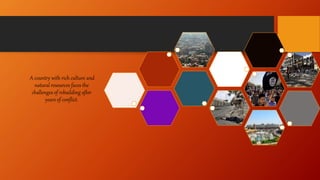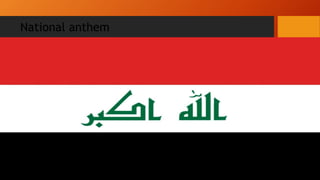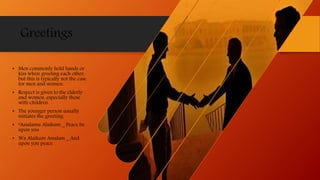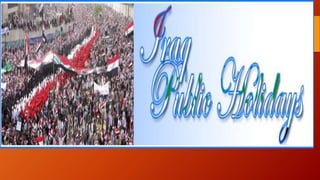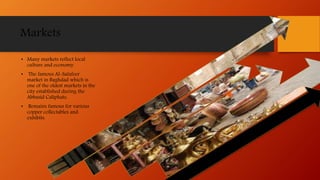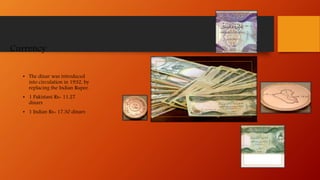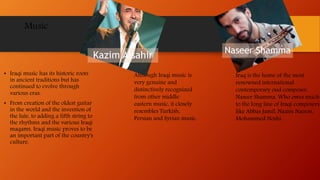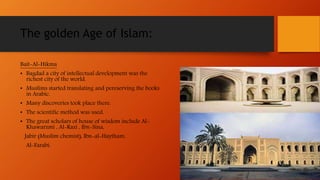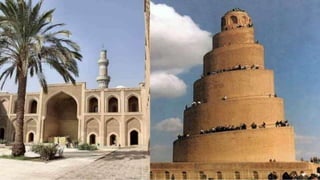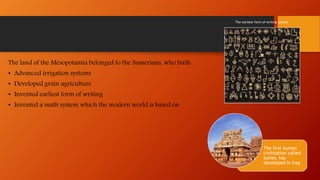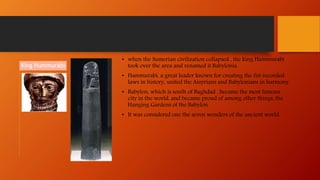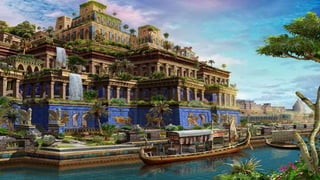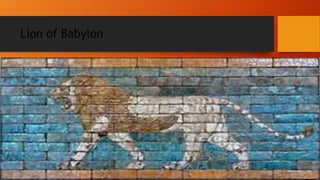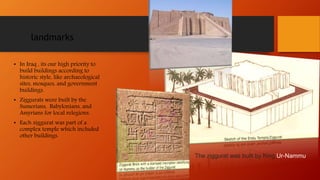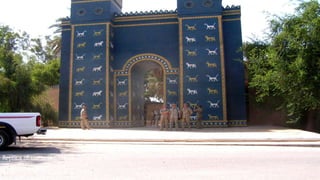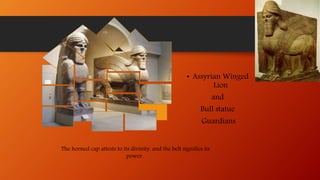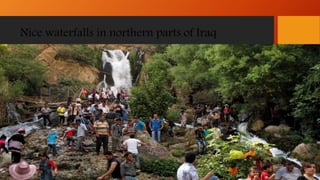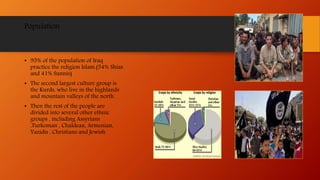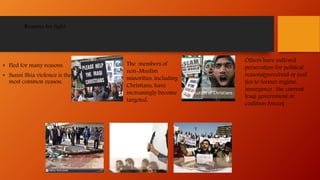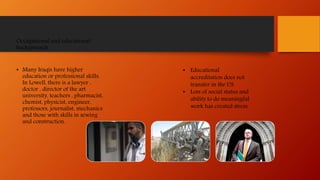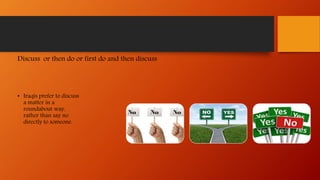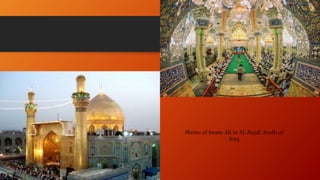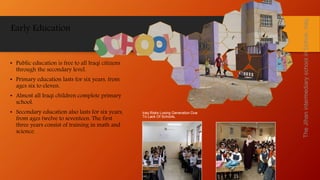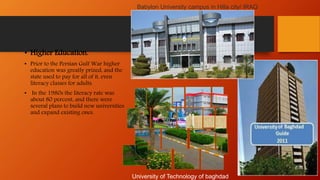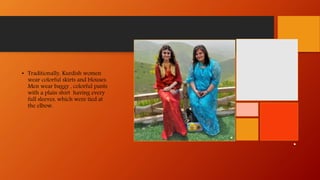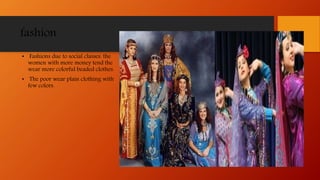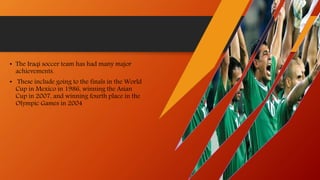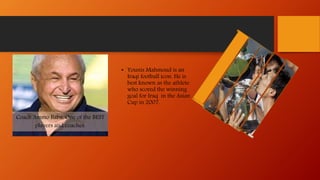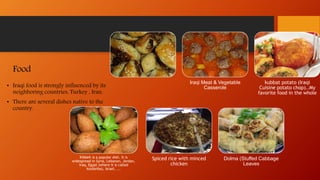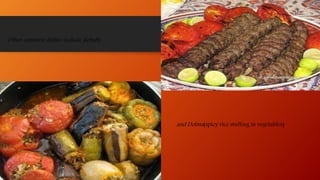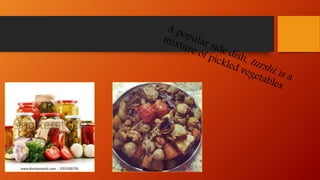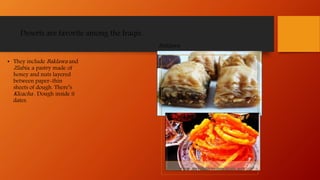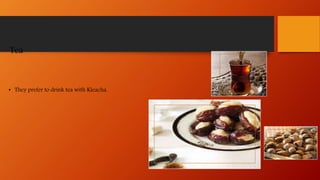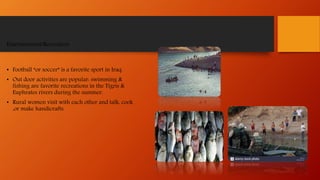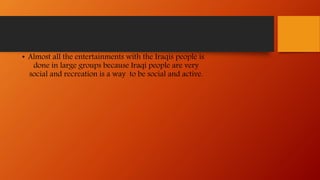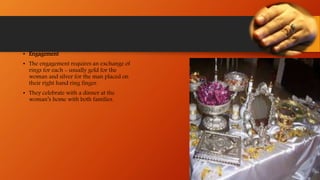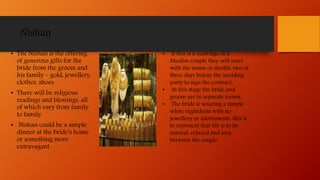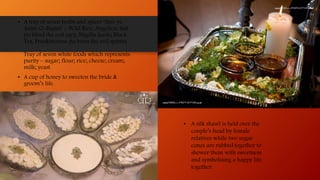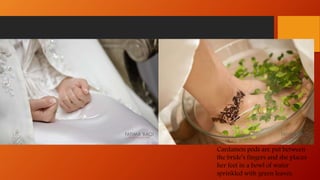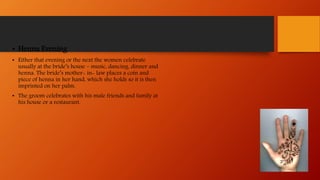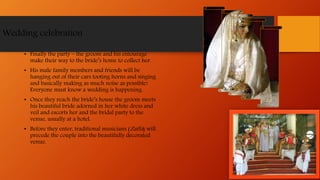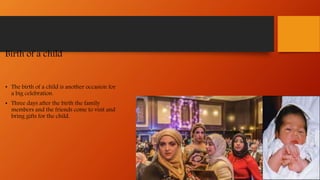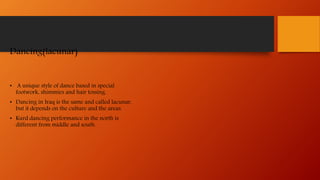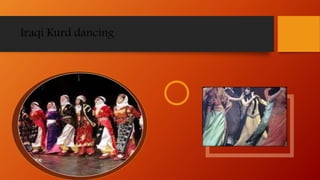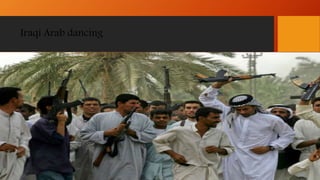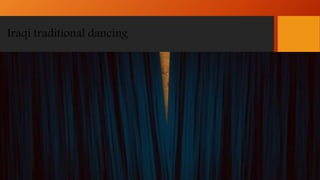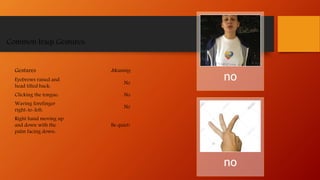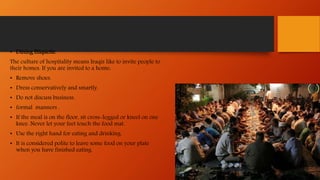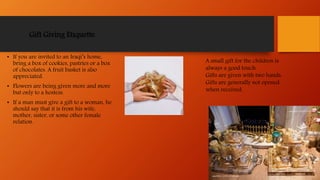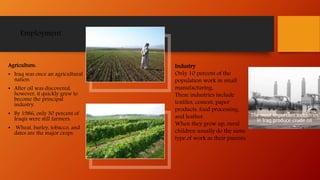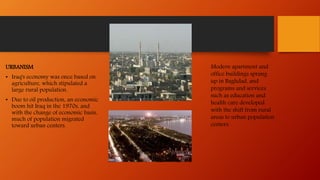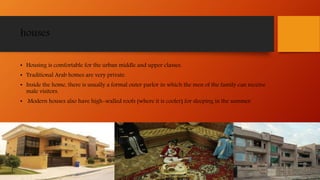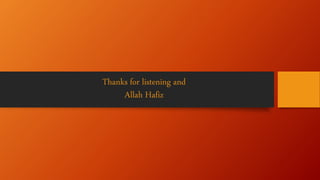Iraqi culture
- 1. 543210
- 4. A country with rich culture and natural resources faces the challenges of rebuilding after years of conflict.
- 5. Geography of Iraq Iraq in the middle east, bordered by Iran, Jordan , Kuwait , Saudi Arabia , Syria and Turkey.
- 6. Republic of Iraq • The federal government of Iraq is defined under the current Constitution as the democratic, federal parliamentary Islamic republic. • Elections take place every four years and people will elect member of the parliament then members will elect a prime minister who has all the authorities. • Federal government is composed of executive, legislative, and judicial branches, as well as small independent commissions. • Aside from the federal government, there are regions called province. • Iraq has eighteen provinces.
- 8. Languages: • There are a number of languages spoken in iraq, but mesopotamian arabic (iraqi arabic) is by far the most widely spoken in the country. • Arabic is the majority language, kurdish is spoken by approximately 15-20% of the population, turkmen, neo-aramaic languages and others by 5% Iraq is a Muslim nation with Arabic and Kurdish as its official languages.
- 9. Greetings • Men commonly hold hands or kiss when greeting each other, but this is typically not the case for men and women. • Respect is given to the elderly and women, especially those with children. • The younger person usually initiates the greeting. • “Assalamu Alaikum _ Peace be upon you • Wa Alaikum Assalam _ And upon you peace
- 10. Holidays • As such, Islamic holidays are celebrated. Other holidays include the Nawroz, the Iraqi Army Day, and the International Workers’ holiday.
- 12. Weekends • Weekends in Iraq are Friday and Saturday, as opposed to the Western version of Saturday and Sunday.
- 13. Current president • Haider Jawad Kadhim Al-Abadi (or al-'Ibadi; born 25 April 1952) is an Iraqi politician who has been Prime Minister of Iraq since September 2014. Previously he served as Minister of Communication from 2003 to 2004, in the first government after Saddam Hussein. . He was designated as Prime Minister by President Fuad Masum on 11 August 2014 to succeed Nouri al-Maliki and was approved by the Iraqi parliament on 8 September 2014. Political party: Islamic Dawa party
- 14. Markets • Many markets reflect local culture and economy. • The famous Al-Safafeer market in Baghdad which is one of the oldest markets in the city established during the Abbasid Caliphate. • Remains famous for various copper collectables and exhibits.
- 15. • Iraqi cities are famous for their dedicated traditional market places which reflect local culture, folklore and economy. • Baghdad for one is famous for such places;Astarabadi (textile mall), Mutanabi (for books), Al- Nahar (Goldsmith and Silver jewelry), Shorja (spices) and Al-Safafeer (copper-smiths) , which is one of the oldest markets in the city established during the Abbasid Caliphate (around 1200A.D.) and remains famous for various copper collectibles and exhibits
- 16. Currency • The dinar was introduced into circulation in 1932, by replacing the Indian Rupee. • 1 Pakistani Rs= 11.27 dinars • 1 Indian Rs= 17.30 dinars
- 17. Recreational institutions • Several institutions in Iraq boast the recreational culture of live theatre. Notable institutions in Baghdad include the Iraqi National Orchestra and the National Theatre of Iraq. • Cultural education is fostered through institutions such as the Academy of Music and the Institute of Fine Arts.
- 18. flag • The flag of Iraq is an important national symbol. • It is composed of three colored, horizontal sections: red on the top, white in the middle, and black on the bottom. The phrase Allahu Akbar “God is great” appears on the white band of the flag. Iraqi flag Red refers to every drop of Iraqi blood shed on the earth without guilt just to protect the homeland. White refers to the pure hearts of the Iraqis. Black refers to the many good things in Iraq and large palm forests.
- 19. Music • Iraqi music has its historic roots in ancient traditions but has continued to evolve through various eras. • From creation of the oldest guitar in the world and the invention of the lute, to adding a fifth string to the rhythms and the various Iraqi maqams, Iraqi music proves to be an important part of the country's culture. Although Iraqi music is very genuine and distinctively recognized from other middle eastern music, it closely resembles Turkish, Persian and Syrian music. Kazim Alsahir Iraq is the home of the most renowned international contemporary oud composer, Naseer Shamma. Who owes much to the long line of Iraqi composers like Abbas Jamil, Nazim Naeem, Mohammed Noshi. Naseer Shamma
- 20. Ancient Mesopotamia • Iraq is located in southwestern Asia , in the heart of the Middle East. • Iraq Is about the size of California. • Rivers, Tigris and Euphrates, run through the center of Iraq. • These provide Iraq with agriculturally capable land and contrast with the steppe and desert landscape that covers most of western asia. Iraq covers most of the area of the ancient Mesopotamia, which centered on the land between the Tigris and the Euphrates Rivers. Mesopotamia, also called to as the “fertile Crescent” was an important center of the early civilization.
- 21. Historically , Iraq was the center of the Abbasid Caliphate.(750-1258) • Settled in area that was once part of Persian empire. • They adopted Persian customs, and hired Persian officials and lived luxurious life. • They valued learning and educational persuits. • Began after overthrow of Umayyad caliphs in 750CE. They were responsible for advances in : • Medicine • Mathematics • Literature and poetry • Art • Publishing
- 22. The golden Age of Islam: Bait-Al-Hikma • Bagdad a city of intellectual development was the richest city of the world. • Muslims started translating and pereserving the books in Arabic. • Many discoveries took place there. • The scientific method was used. • The great scholars of house of wisdom include Al- Khawarzmi , Al-Razi , Ibn-Sina, Jabir (Muslim chemist), Ibn-al-Haytham, Al-Farabi.
- 23. Landmarks of Abbasid Empire • The Abbasid caliphate built the city of Baghdad in the 8th century as their capital, and it became the leading metropolis of the Arab and Muslims world for five centuries. • Baghdad was the largest multicultural city of the middle ages, peaking at a population of more than a million, and was the center of learning during the Islamic golden age. • Minaret malwiya and mustansiriya school are one of the landmarks of the abbasid empire.
- 25. • Baghdad capital city of Iraq, was the headquarters of the Abbasid Empire which stretched out Islam all over Asia and beyond. • They built many mosques, schools, universities all in one. Math and Science books destroyed by the Mongols, Madrasa Al-Mustansiriya
- 26. The land of the Mesopotamia belonged to the Sumerians, who built: • Advanced irrigation systems • Developed grain agriculture • Invented earliest form of writing • Invented a math system which the modern world is based on The first human civilization called sumer, has developed in Iraq The earliest form of writing system
- 27. • Invented the wheel • Invented the first plow • Literature was produced , including the first known recorded story, the Epic of Gilgamesh . • Science and art
- 28. • when the Sumerian civilization collapsed , the king Hammurabi took over the area and renamed it Babylonia. • Hammurabi, a great leader known for creating the fist recorded laws in history, united the Assyrians and Babylonians in harmony. • Babylon, which is south of Baghdad , became the most famous city in the world, and became proud of among other things, the Hanging Gardens of the Babylon. • It was considered one the seven wonders of the ancient world. King Hummurabi
- 30. Abraham prophet • Abraham from old testament originated from Ur of Chaldies.
- 31. • It was built by Chaldean Nebuchadnazzer II, to please his sick wife, Amytis who loved trees and plants for her homeland Persia. • Babylonia became the part of the Persian empire, until Arab Muslims took over it • The gardens were destroyed by several earth quakes.
- 32. Lion of Babylon
- 34. • In Iraq , its our high priority to build buildings according to historic style, like archaeological sites, mosques, and government buildings. • Ziggurats were built by the Sumerians, Babylonians, and Assyrians for local relegions. • Each ziggurat was part of a complex temple which included other buildings. The ziggurat was built by King Ur-Nammu landmarks
- 35. Replica of the real Gate of Temple of Ishtar
- 36. • Assyrian Winged Lion and Bull statue Guardians The horned cap attests to its divinity, and the belt signifies its power.
- 37. Nice waterfalls in northern parts of Iraq
- 39. • The northern parts of Iraq are the mountains and experience cold, harsh winter, and pleasant summer months. The average temperatures in Iraq range from higher than 48 degree C (120 Fahrenheit) in July and August to below freezing in January.
- 40. • In summer , a dry, dusty wind called the shamal blasts through the country with dust storms, lasting for several days. • Since the country is so dry , these are few plants, except for the date palm tree, known for its dates. • In fact, more than 80% of the world’s date supply is grown in Iraq.
- 41. More than 200 kinds in Iraq
- 43. Population • 95% of the population of Iraq practice the religion Islam.(54% Shias and 41% Sunnis) • The second largest culture group is the Kurds, who live in the highlands and mountain valleys of the north. • Then the rest of the people are divided into several other ethnic groups , including Assyrians ,Turkoman , Chaldean, Armenian, Yazidis , Christians and Jewish
- 44. Difference between Sunni and Shia • Iraqi Muslims are split in two groups the Sunni and Shia. • They share the fundamental Islamic believes. • Main difference is political. • When the Prophet Muhammad(PBUH) died, the Sunni believed that any one could be the religious leader, but Shia believed only the descendants of Muhammad could. • Shia is the majority in Iraq , but minority in middle east.
- 45. The Extended family structure • The extended family or tribe is the main unit in the Iraqi society. • It yields considerable influence in the decision making process of individual and society. • Family honor comes before other social relationships. It is common for large extended families to live in the same houses, compound or village. In urban Areas families do not necessarily live in same house, although they generally live in the same street or suburb at least.
- 46. Collectivist society • Arab culture is the collectivist culture where the individual relinquishes the self and obeys the will of group/society. • Those who have been exposed to western culture may practice individualistic styles of life in the privacy of their homes but respect and adhere to the collectivist style outside.
- 47. Reasons for fight • Fled for many reasons. • Sunni Shia violence is the most common reason. Others have suffered persecution for political reasons(perceived or real ties to former regime, insurgency , the current Iraqi government or coalition forces) The members of non-Muslim minorities, including Christians, have increasingly become targeted. Persecution of Christians
- 48. Characteristics of refugees • Low vaccination rate for children, high rate of diarrhea for children, war related injuries. • Psychological distress due to traumatizing events in Iraq including torture, kidnapping, blackmail, rape, intimidation and harassments by militia and neighbors. Christian refugee camp in Erbil, Iraq
- 49. Occupational and educational backgrounds • Many Iraqis have higher education or professional skills. In Lowell, there is a lawyer , doctor , director of the art university, teachers , pharmacist, chemist, physicist, engineer, professors, journalist, mechanics and those with skills in sewing and construction. • Educational accreditation does not transfer in the US. • Loss of social status and ability to do meaningful work has created stress.
- 50. Discuss or then do or first do and then discuss • Iraqis prefer to discuss a matter in a roundabout way, rather than say no directly to someone.
- 51. Shrine of Imam Ali in Al-Najaf, South of Iraq
- 52. Imam Abu Hanifa Shrine on Prophet Muhammad’s (P.B.U.H) Birthday The grave of Imam Abu Hanifa in Iraq
- 53. Mountains in north of Iraq
- 54. Early Education • Public education is free to all Iraqi citizens through the secondary level. • Primary education lasts for six years, from ages six to eleven. • Almost all Iraqi children complete primary school. • Secondary education also lasts for six years, from ages twelve to seventeen. The first three years consist of training in math and science. TheJihanintermediaryschoolinDohuk,Iraq. Iraq Risks Losing Generation Due To Lack Of Schools,
- 55. • Higher Education. • Prior to the Persian Gulf War higher education was greatly prized, and the state used to pay for all of it, even literacy classes for adults. • In the 1980s the literacy rate was about 80 percent, and there were several plans to build new universities and expand existing ones. University of Technology of baghdad Babylon University campus in Hilla city/ IRAQ
- 57. • The traditional dress that that Iraqi men wear is the dishdasha . • The shmag , a white or checkered square scarf folded into a triangle and sometimes worn over a small white cap with the agal , a circular black rope to hold the Shmag in place. The traditional costume includes the abayah , a long black cloak worn over a dress and covering the wearer form head to foot.
- 58. • Traditionally, Kurdish women wear colorful skirts and blouses. Men wear baggy , colorful pants with a plain shirt having every full sleeves, which were tied at the elbow.
- 59. fashion • Fashions due to social classes. the women with more money tend the wear more colorful beaded clothes. • The poor wear plain clothing with few colors.
- 60. sports • Football is the most popular sport in Iraq. • Other popular sports in Iraq include wrestling , volleyball , taekwondo , Karate and basketball. taekwondo vollyball wrestling karate
- 61. • The Iraqi soccer team has had many major achievements. • These include going to the finals in the World Cup in Mexico in 1986, winning the Asian Cup in 2007, and winning fourth place in the Olympic Games in 2004
- 62. Coach Ammo Baba, One of the BEST players and coaches. • Younis Mahmoud is an Iraqi football icon. He is best known as the athlete who scored the winning goal for Iraq in the Asian Cup in 2007.
- 63. Art and crafts
- 64. The country of Iraq is known for its poets and painters and sculptors whom are among the best in the Arab world. • World renowned Iraqi painters and sculptors include Ismail Fatah Al Turk, Khalid Al Rahal, Mohammed GhaniHikmat and Faeq Hassan. • Handicrafts are very popular in Iraq. • Most crafts are in the form of jewelry, rugs, blankets, leather, and pottery. oil painting by Faeq Hassan Great poets Abu Al Tayeb Al Mutanbi of the Abbasid Period. Modern- era poetic contributors include Mohammad Mahdi Al Jawahiri.
- 65. Food • Iraqi food is strongly influenced by its neighboring countries, Turkey , Iran. • There are several dishes native to the country. Iraqi Meat & Vegetable Casserole kubbat potato (Iraqi Cuisine potato chop)..My favorite food in the whole Spiced rice with minced chicken Dolma (Stuffed Cabbage Leaves Kibbeh is a popular dish. It is widespread in Syria, Lebanon, Jordan, Iraq, Egypt (where it is called koubeiba), Israel, ...
- 66. Fish Masgoof is a fish on a stick barbequed on an outdoor grill.
- 67. Other common dishes include kebabs and Dolma(spicy rice stuffing in vegetables)
- 69. biryani Chicken with fruits • Other popular dishes include Chicken with Fruit, Kubbat Burghul , Kubat Halab , Biryani etc.
- 70. Deserts are favorite among the Iraqis. • They include Baklawa and Zlabia, a pastry made of honey and nuts layered between paper-thin sheets of dough. There’s Kleacha . Dough inside it dates. Baklawa Zlabia
- 71. Tea • They prefer to drink tea with Kleacha.
- 72. Hospitality Iraqis are known for being very generous and polite , especially when it comes to mealtime. Many Iraqis feed their guests well before themselves.
- 73. • Most Iraqis hosts feel that they are failing in their role as hosts if their guests have not tried all of their dishes. • A tradition within Islam actually stipulates someone is allowed to stay in your home for 3 days before you can question why they are staying and when they will leave. • Invitations to a home must be seen as a great honor and never turned down.
- 74. Entertainment/Recreation • Football “or soccer” is a favorite sport in Iraq. • Out door activities are popular: swimming & fishing are favorite recreations in the Tigris & Euphrates rivers during the summer. • Rural women visit with each other and talk, cook ,or make handicrafts.
- 75. • Almost all the entertainments with the Iraqis people is done in large groups because Iraqi people are very social and recreation is a way to be social and active.
- 76. The Iraqi National Symphony Orchestra Chief Principal Conductor Karim Wasfi leads the Iraqi National Symphony Orchestra during a concert in Baghdad
- 77. Wedding Mashaya & Sharbet • Men from the groom’s family go to meet the men on the bride’s side with a formal marriage proposal. • Asked formally by her father if she will accept the offer of marriage. • Once she agrees the Fatiha is read and then the families celebrate by sharing ‘sharbet’ which is a delicious fruit coridal often flavoured with rose water and pomegranate. • Turkish coffee and dessert is also served. Traditionally, their weddings would consist of seven steps and rituals, today some of these steps can merge. They also share many traditions with their Iranian neighbors.
- 78. • Engagement • The engagement requires an exchange of rings for each - usually gold for the woman and silver for the man placed on their right hand ring finger. • They celebrate with a dinner at the woman’s home with both families.
- 79. Nishan • The Nishan is the offering of generous gifts for the bride from the groom and his family – gold, jewellery, clothes, shoes. • There will be religious readings and blessings, all of which vary from family to family. • Nishan could be a simple dinner at the bride’s home or something more extravagant. • If this is a marriage of a Muslim couple they will meet with the imam or sheikh, two or three days before the wedding party to sign the contract. • At this stage the bride and groom are in separate rooms. • The bride is wearing a simple white nightdress with no jewellery or adornments, this is to represent that life is to be natural, relaxed and easy between the couple.
- 80. • She agrees then goes to another room to change into a dress that her mother-in-law has bought her. • They are seated at the elaborately decorated table ‘Mez al Sayed’. Mez al Sayed Items • A mirror is facing them with a candelabra on either side; the Holy Book; • A basket of decorated eggs and a basket of decorated almonds, walnuts and hazelnuts in the shell; pomegranates & red apples; • A bowl of gold coins and a treasure box with pearls & crystals.
- 81. • A tray of seven herbs and spices ‘Sini-ye Aatel-O-Baatel’ - Wild Rice; Angelica; Salt (to blind the evil eye); Nigella Seeds; Black Tea, Frankincense (to burn the evil spirits) Tray of seven white foods which represents purity – sugar; flour; rice; cheese; cream; milk; yeast. • A cup of honey to sweeten the bride & groom’s life. • A silk shawl is held over the couple’s head by female relatives while two sugar cones are rubbed together to shower them with sweetness and symbolising a happy life together.
- 82. Cardamon pods are put between the bride’s fingers and she places her feet in a bowl of water sprinkled with green leaves.
- 83. • Henna Evening • Either that evening or the next the women celebrate usually at the bride’s house – music, dancing, dinner and henna. The bride’s mother- in- law places a coin and piece of henna in her hand, which she holds so it is then imprinted on her palm. • The groom celebrates with his male friends and family at his house or a restaurant.
- 84. Wedding celebration • Finally the party – the groom and his entourage make their way to the bride’s home to collect her. • His male family members and friends will be hanging out of their cars tooting horns and singing and basically making as much noise as possible! Everyone must know a wedding is happening. • Once they reach the bride’s house the groom meets his beautiful bride adorned in her white dress and veil and escorts her and the bridal party to the venue, usually at a hotel. • Before they enter, traditional musicians (Zaffa) will precede the couple into the beautifully decorated venue.
- 86. Birth of a child • The birth of a child is another occasion for a big celebration. • Three days after the birth the family members and the friends come to visit and bring gifts for the child.
- 87. Dancing(lacunar) • A unique style of dance based in special footwork, shimmies and hair tossing. • Dancing in Iraq is the same and called lacunar, but it depends on the culture and the areas. • Kurd dancing performance in the north is different from middle and south.
- 92. Grief and family support • When a loved one dies the whole family, friends and relatives gather around to support financially, emotionally and physically. • During the first few months the relatives of the deceased and friends provide time, food emotional, and financial support.
- 93. Funeral traditions • After special prayers for the deceased in the hall, the whole community gathers men on one side and women on the other side. • A pot luck will be provided by the relatives and friends of the deceased for all who attended the funeral. • Special ceremonies are held on two occasions the seventh and fortieth day of the deceased loved one. • The first seven days are very intense, the whole community offer their condolences to the relatives of the deceased. The family and relatives of the deceased prepare food for all visitors. Closest relatives and friends visit often until forty days and even longer
- 94. Festivals of Iraqi people festivals National Based on solar calendar Islamic Based on lunar calendar Only Muslims practice Common in all Iranians
- 95. National festivals • Nawruz(new year festival March 21). • Mehrgan (Autumn festival on 9th of October , thanksgiving festival). • Yalda ( the winter fiesta on 21st of December, longest night of the year). • Sadeh( the fire festival on 31st of Jan, to defeat the forces of darkness). • Chahar-shanbe suri ( Red Wednesday bonfire festival on the last Wednesday of the year). Dancers performing on Nawruz festival yalda Naoroz festival celebrated in iraq Sadeh festival
- 96. Islamic festivals Shias Ashura Is the remembrance of martyrdom of the 3rd Imam in Shia Mid- Shaban ( birth of12 th imam) All Muslims Eid-e-Qurban Ramadan Eid-e-Fitr
- 97. Common Iraqi Gestures: Gestures Meaning Eyebrows raised and head tilted back: No Clicking the tongue: No Waving forefinger right-to-left: No Right hand moving up and down with the palm facing down: Be quiet! no no
- 98. Sign of victory Go away Sign of sincerity Come here
- 99. Etiquette and Customs in Iraq • Meeting People • The most common greeting is the handshake coupled with eye contact and a smile. • The standard Arabic/Islamic greeting is "asalaamu alaikum" ("peace be with you"), to which the response is "wa alaikum salaam" ("and peace be unto you"). • Good friends of the same sex may greet each other with a handshake and a kiss on each cheek, starting with the right. • Expect to be introduced to each person individually at a small social function. At a large function, you may introduce yourself.
- 100. • Dining Etiquette The culture of hospitality means Iraqis like to invite people to their homes. If you are invited to a home: • Remove shoes. • Dress conservatively and smartly. • Do not discuss business. • formal manners . • If the meal is on the floor, sit cross-legged or kneel on one knee. Never let your feet touch the food mat. • Use the right hand for eating and drinking. • It is considered polite to leave some food on your plate when you have finished eating.
- 101. • If you are invited to an Iraqi’s home, bring a box of cookies, pastries or a box of chocolates. A fruit basket is also appreciated. • Flowers are being given more and more but only to a hostess. • If a man must give a gift to a woman, he should say that it is from his wife, mother, sister, or some other female relation. A small gift for the children is always a good touch. Gifts are given with two hands. Gifts are generally not opened when received. Gift Giving Etiquette
- 102. Living conditions • The middle and upper classes in Iraq enjoy much better living conditions than does the lower class. • Lower class, mostly rural dwellers, live in reed and mud huts, generally without electricity or running water. • Doctors and nurses tend to cluster in larger cities, so there is a serious lack of health care available in rural areas. • Housing is comfortable for the urban middle and upper classes. • Traditional Arab homes are very private.
- 103. Employment Agriculture: • Iraq was once an agricultural nation. • After oil was discovered, however, it quickly grew to become the principal industry. • By 1986, only 30 percent of Iraqis were still farmers. • Wheat, barley, tobacco, and dates are the major crops. Industry Only 10 percent of the population work in small manufacturing. These industries include textiles, cement, paper products, food processing, and leather. When they grow up, rural children usually do the same type of work as their parents. The most important industries in Iraq produce crude oil
- 104. URBANISM • Iraq's economy was once based on agriculture, which stipulated a large rural population. • Due to oil production, an economic boom hit Iraq in the 1970s, and with the change of economic basis, much of population migrated toward urban centers. Modern apartment and office buildings sprang up in Baghdad, and programs and services such as education and health care developed with the shift from rural areas to urban population centers.
- 105. • SOCIALIZATION • Infant Care. • Children are the mother's responsibility, and in extended domestic units other female members also take care of the children. Children normally imitate older siblings, and obedience and loyalty to elders are of vital importance. • Child Rearing and Education. The family holds an important role in teaching values, and they consider it their duty and feel responsible for other family members' behaviors. • A good child is loyal, obedient, and does not question authority.
- 106. houses • Housing is comfortable for the urban middle and upper classes. • Traditional Arab homes are very private. • Inside the home, there is usually a formal outer parlor in which the men of the family can receive male visitors. • Modern houses also have high-walled roofs (where it is cooler) for sleeping in the summer.
- 107. Cultural heritage: • Sumerians, thought to be the first advanced civilization on Earth. • The most famous literary works to emerge from this tradition are the Epic of Gilgamesh(an Akkadian hero tale) and The Thousand and One Nights(a collection of Arab folk tales). • Modern Iraqi literature is becoming Westernized. Illustration of One Thousand and One Nights
- 108. • National Museum of Iraq: • This museum is located in Baghdad, Iraq. • Also known as the Iraq Museum, it contains relics from the Mesopotamian civilization which are said to be among the most important in the world. • The museum chronicles the development of human civilization with artifacts dating back more than 10,000 years from the Sassanid, Assyrian, Babylonian, Sumerian, Akkadian and Ottoman dynasties as well as Stone Age and Prehistoric artifacts. Important artifacts from the over 5,000 year long history of Mesopotamia are on display in 28 galleries in both English and Arabic languages. "Winged human-headed bull"Assyrian Period, reign of Sargon II (721-705 BC) Khorsabad, ancient Dur Sharrukin, Assyria, Iraq
- 109. Baghdad Museum: • This museum is located near Shuhada (Martyrs) Bridge at the area where in the old Round City of Baghdad was originally established. • The museum houses paintings, photographs, maps and illustrative materials that showcase the city's history. • In addition, the museum depicts the folk heritage of Iraqi customs and traditions. A multilingual library is located in the museum.
- 110. Museum of Natural History: This museum is located in Rasafa, Baghdad and highlights Iraqi wildlife and biology. The museum showcases Iraqi history through various animals and plants and houses 26,000 books that delve even further into the history of Iraq. Kurdish textile meuseum Located in an elegant house inside the front gates of the Erbil Citadel, this museum offers a look at the cultural heritage of Kurdish people through the intricacy of Kurdish weaving.
- 112. Thanks for listening and Allah Hafiz



